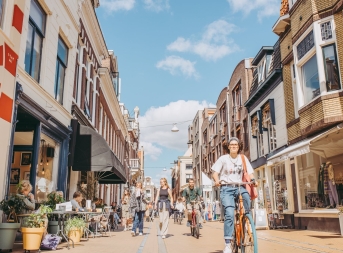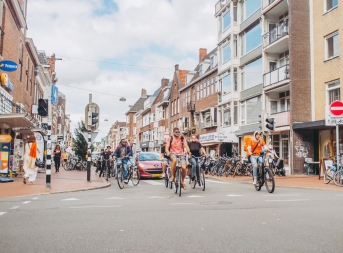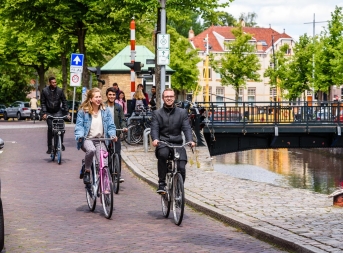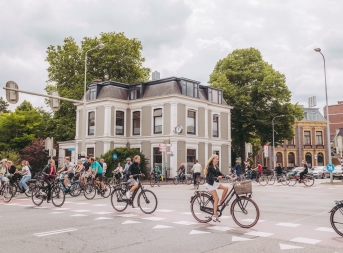Groningen is made for bikes – literally. The city is designed to make cycling the quickest, easiest and cheapest way to get from point A to point B. But for new residents in the city, figuring out the rules can be daunting. Here’s (pretty much) everything you need to know about buying a bicycle in Groningen, learning to bike safely, and how Groningen became the world’s premier cycling city.
Where to get a bike: go second hand
Buying a bike in Groningen is very easy, as long as you know where you to get one. No matter where you buy your bike, be sure to give it a test "drive" before purchasing it, and find one with a low enough frame and seat that your feet can be flat on the ground when you stop. Bike seats can also be lowered, and the saddle should come up to your hips when you stand beside it. There's no shame in asking for children's bike if that is the right height for you.
We recommend buying a used bike from any of the dozens of bike shops in town. Second hand bikes are also sold by the municipality (gemeente) at WerkProton Stallingen (Protonstraat 6) or Refidé Bikes (Blauwborgje 12 on the Zernike Campus).
Prices start at €125 (payment by card only), and all the bikes there have been thoroughly inspected to ensure their locks and lights are working properly, and – most importantly – are not stolen.
Bike theft is an unfortunate rite of passage for many a Groninger, Dutch and international alike, and those bikes are often turned right around and sold to unsuspecting students. Unless you have access to a private bike shed (or several heavy-duty bike locks), used bikes are the way to go: new bicycles tend to be targeted more frequently for theft.
Another option: Swapfiets. For a monthly fee, these blue-tire bikes can be swapped out if they are broken or damaged - but again, check the frame to make sure you can bike safely!
For those with mobility issues, you can also buy an e-bike, a tricycle (driewieler) designed for adults, or a recumbent bike (ligfiets).
Another golden rule for Groningen: you can’t just leave your bike parked in most places indefinitely. At locations like the main train station, the Groninger Forum and most designated bike parking garages, there’s a maximum of 12 days for parking your bike. After that, it will be moved to the AFAC Bike Depot on the Travertijnstraat (AFAC stands for Algemene Fiets Afhandel Centrale: General Bicycle Processing Center). Check out their website for a full list of places in town where you bike will be towed away after 12 days.
How to bike: FietsFriend
It’s a fact recognized world-wide that Groningen is made for bikes, but figuring out Dutch traffic rules is an intimidating task for the thousands of new international residents who move to the city annually. While nearly every native Dutch citizen grows up learning to cycle, that is less of a given in the rest of the world: only about 50 percent of households worldwide own a bicycle.
Approximately 4,000 new international students enrol at the RUG and Hanze each academic year, and photos of students who have accidently ended up on the city’s ring road are unfortunately a regular occurrence, as are harrowing anecdotes of internationals of near misses or (minor) collisions.
This lack of understanding of national (and local) traffic rules put all road users at risk, which is why City Central Groningen launched FietsFriend: to help internationals cycle safely and fully enjoy the biking lifestyle in Groningen.
The programme has three options:
Rules of the Road workshops lead you through the heart of town and explain the essentials for how to stay safe on the Dutch roads, from how right of way works at intersections to what traffic signs and lights mean for cyclists.
If you need to learn how to ride a bike in the first place, or could just use a confidence boost before merging onto Groningen’s relentless bike lanes, you can also request a FietsFriend One-on-One cycling lesson.
Once you feel like you’ve got the hang of this whole Dutch cycling thing, sign up for a FietsFriend Outing to a (surprise) destination in the province by bike.
Tricky traffic situations
Here are the absolute fundamental rules of the road that everyone cycling on Groningen’s competitive streets should know to stay safe. Click the links to see what the signs and/or road markings look like, so you'll know what to look out for.
Signal: if you are turning, be sure to stick out your arm before you turn to let people around you know where you're going. Bikes don't have indicators like cars, so you've got to use your hands: left if you're going left, right if you're going right.
Priority: Traffic coming from the right of way has priority.
Shark teeth (Haaientanden): These white triangles mean yield. So if you are in the bike lane, or on the road, and you have the shark teeth pointing at you, you have to yield to traffic coming from other directions.
At the same time green (Tegelijk groen): traffic from all directions can cross the intersection at the same time. This is unique to Groningen! The best way to navigate this is to make eye contact with the people in the direction you are going, and aim for an open spot in the flow of traffic. You have to pay attention to your surroundings, and exude confidence (fake it ‘til you make it). Even here though, you still have to keep in mind that traffic from the right has more priority, and there are still shark teeth.
Turn right for cyclists clear (Rechtsaf voor fietsers vrij): Cyclists can turn right at the light. Most intersections in the Netherlands do not permit cyclists (or motorists) to turn right on red. But if you see this sign, it means you can. It’s usually at intersections where there’s enough space to turn right without cars or buses having a blind spot where they may not see you.
Exception (Uitgezonderd): You’ll see this word underneath one way and no entry traffic signs, and usually black symbols underneath for different modes of transportation. This means that most traffic cannot enter that road, except for the symbols: bikes are almost always uitgezonderd in these situations.
More cycling tips
- Check out these free online guidebooks:
- Traffic in the Netherlands
-Learning to cycle handbook for students
- If you’re more of a visual learner, Groningen Fietsstad has a very helpful video explaining how to navigate one of Groningen’s more unique traffic features: intersections cyclists from all directions have a green light at the same time (be sure to turn on English subtitles).
- The Northern Times, an English-language news site covering the north, also has a brilliant overview of local cycling rules, including what will earn you a fine and how much it can cost.
- For more general information on cycling in the Netherlands, have a look at the overview on the I Am Expat website with a list of biking terms in English and Dutch that will come in handy you when you want to buy a bike, rent a bike or get your bike repaired.



